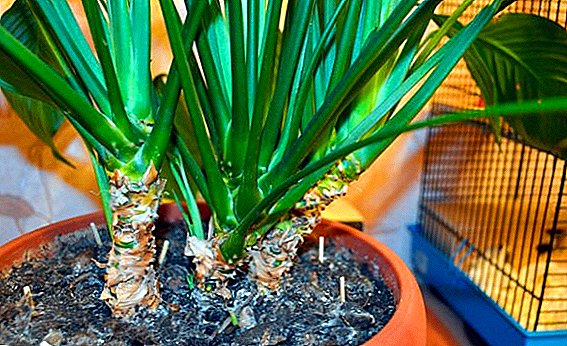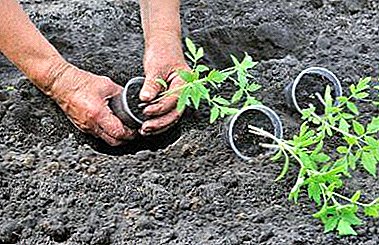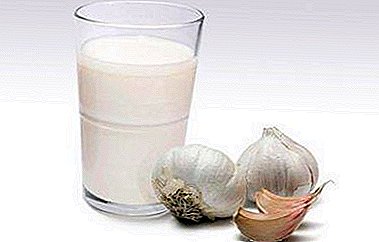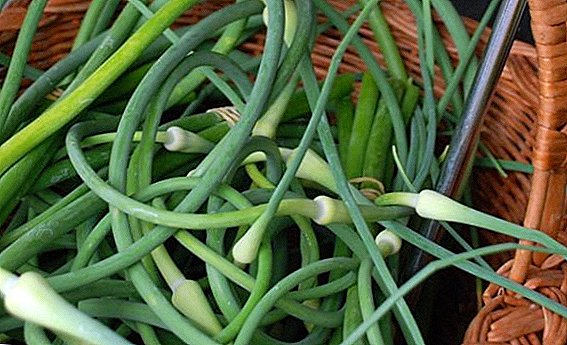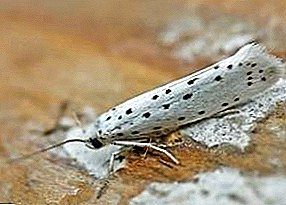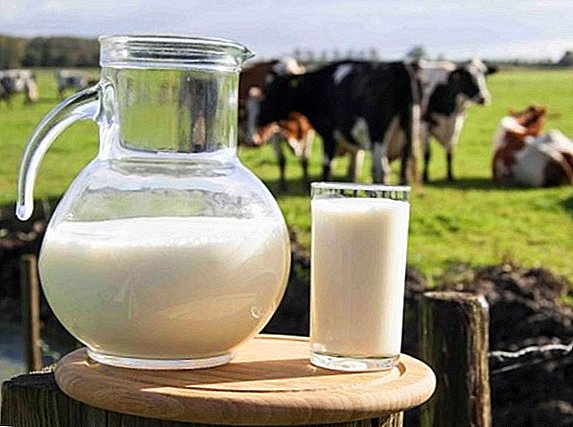 The problem of bitter taste in cow's milk touched every farmer at least once in their lives. In order to timely identify the causes of trouble, and then correctly eliminate it, you should perform a number of preventive and therapeutic measures described in this material.
The problem of bitter taste in cow's milk touched every farmer at least once in their lives. In order to timely identify the causes of trouble, and then correctly eliminate it, you should perform a number of preventive and therapeutic measures described in this material.
Why do cows have bitter milk before calving
The only periods when milky bitterness can be considered normal, not a pathological phenomenon, are the approaching calving and feeding of offspring. With the onset of pregnancy, the cow's body is undergoing a strong hormonal adjustment, gradually changing the previous chemical composition of milk to a new one, intended only for feeding the newborn calf.
In general, palpable bitterness occurs due to the growth of leukocytes, casein protein, and the splitting enzyme lipase found in the product. Therefore, it is better to wait a little with the milk yield of a female cow “in the launch” (2 months before calving and 2-3 after).
Did you know? Thunderstorm can contribute to the souring of milk, even if it is in the refrigerator. Biochemists have discovered that the fault of long-wave electromagnetic pulses, which can easily penetrate into any substance. And most often from them spoil dairy products.
Why is the milk souring when souring
There are other factors that influence the change in milk taste for the worse:
- diet;
- infectious and parasitic diseases;
- congenital abnormalities;
- violation of hygienic norms when milking a cow;
- violation of the proper storage conditions of the "white product".

Eats bitter herbs
Quite often, the bitterness that has appeared can be attributed to some herbs that animals find and eat on pastures during walking. The number of edible for the cow, but distorting the milk taste of plants include: wormwood, horse garlic, sweet clover, avran medicinal, tansy, yarrow and mountain ash.
We advise you to read about how and how many times to milk a cow, and also to find out what to do if there is blood in the milk.
Also an important niche in the development of high-quality milk is a properly formulated and healthy diet, so it is important for the farmer to adjust some points in time:
- When buying feed, pay attention to the quality and content of vitamin-mineral substances indicated on the bags (packs). An unbalanced diet causes an increased acidity of the stomach in a cow, and as a result - a bad taste of milk yield;
- monitor the condition of fed barley and oat straw. In case of any putrid tracks, dispose of the affected hay;
- Do not use feed with excessive yeast additives.
 In the winter period, bitterness may occur due to the lack of cobalt - an important trace element that is often lacking in farm soils. The problem can be solved with the help of inexpensive cobalt chloride tablets and a simple scheme: 2 tablets per day for 1 month.
In the winter period, bitterness may occur due to the lack of cobalt - an important trace element that is often lacking in farm soils. The problem can be solved with the help of inexpensive cobalt chloride tablets and a simple scheme: 2 tablets per day for 1 month.Important! The active eating of the land by the little horse or the licking of the walls of houses indicates a lack of mineral substances in the body. In this condition, the female almost immediately begins to produce bitter milk.
Diseases
The second cause of bitterness in the product are common cow diseases.
Helminths in the liver
Parasites that develop in the bovine liver are called fascioli.
Symptoms of the disease:
- the animal begins to cough and sweat heavily on the shoulder blades;
- at the beginning of the disease, the milk is slightly bitter, bitterness gradually increases with souring;
- after souring, the cream blisters heavily, rises by the “cap” and becomes heavily viscous;
- The resulting sour cream has a pronounced bitter taste.

In order to detect the presence of fasciols in the body in time and prevent their further development, the farmer must pass a cow feces for analysis. This veterinary laboratory test is recommended twice a year.
After confirming the diagnosis, the specialist prescribes medicinal injections for animals using these medications:
- "Rolnol";
- "Clover";
- Brontel.
Read more about how to get worms from cows.
The optimal scheme of treatment with injections: a single injection at the rate of 10 ml of the drug per 200 kg of the mass of the cow. The injection is sometimes repeated after 10 days, but only a veterinarian can determine the need for re-manipulation.
Effective powder preparations:
- "Brovalsen";
- Albendazole;
- "Brovadazole".
 Frequently used treatment regimen: twice a day with morning and evening feed.
Frequently used treatment regimen: twice a day with morning and evening feed.Important! Treatment for helminths is almost always successful, but the pronounced milky bitterness does not pass immediately, but gradually, within 10-15 days. Full removal of fasciol and traces of their decay from the body of a cow occurs in 1.5-2 months.
Mastitis
This disease is characterized by a variety of species, each of which manifests itself by different negative changes in the state of the cow and milk:
- greenish gray shade;
- loss of fat;
- mustiness;
- the formation of clots or protein flakes.
The cow loses its appetite, falls into apathy, the body temperature rises significantly, the milk yield decreases rapidly. If any "mastitis" symptoms are detected, the animal should be immediately shown to a specialist.  The characteristic bitterness is manifested only with purulent-catarrhal varieties of mastitis. Related symptoms: saltiness and red color of the product. The affected part of the cow udder hardens, reddens, the lymph node becomes large and firm to the touch.
The characteristic bitterness is manifested only with purulent-catarrhal varieties of mastitis. Related symptoms: saltiness and red color of the product. The affected part of the cow udder hardens, reddens, the lymph node becomes large and firm to the touch.
Successful recovery from mastitis comes after a competent selection by the veterinarian of various antibacterial, anti-inflammatory and immunomodulating drugs. In the role of the main drug most often there are suspensions containing antibiotic, hormonal and enzymatic elements: "Mamifort", "Suit Weixim".
It will be helpful for you to read about how to treat mastitis in a cow.
Homeopathic remedies:
- Traumeel Gel and Vaccine;
- "Echinacea Compositum";
- "Lachesis Compositum".
In addition to prescribed prescribed medications, farmers often turn to proven popular methods:
- water compresses with a cooling or warming effect;
- acupuncture (therapeutic stimulation of the udder with special needles);
- applications of grated carrots, fresh cabbage leaves and beets with honey;
- self-made ointment from aloe, calendula or kelp.
Video: cow mastitis treatment In the acute period of the disease, it is desirable to isolate the animal from the general herd, improve its housing conditions, increase the proportion of fiber (hay), and also conduct milking manually 3-5 times a day.
Leptospirosis
As a rule, this infectious disease affects dairy cows in warm spring or summer, because its pathogens are leptospira bacteria that enter the body of animals through water. In addition to unexpressed bitterness in milk, the symptoms of leptospirosis go unnoticed, gradually reaching a more acute and dangerous form.
Learn what to do and how to treat leptospirosis in cows.
Symptoms of acute leptospirosis:
- sharply "jumping" body temperature;
- severe diarrhea;
- very dark urine;
- pain when urinating;
- signs of jaundice.
It is possible to diagnose the disease by taking the prescribed blood and urine tests, as well as pre-collecting anamnesis by a veterinarian.  After the diagnosis, the animal is prescribed antibacterial drugs:
After the diagnosis, the animal is prescribed antibacterial drugs:
- "Amoxicillin";
- Floridox.
To prevent the development of leptospirosis bacteria in water, timely prevention is recommended:
- regular animal examinations;
- responsible pasture selection for walking;
- complete extermination of rodents on the farm;
- disinfection of the barn and its accessories.
Congenital anomalies
Among the congenital anomalies in cows most often meet the narrowness of the bile ducts and the bends of the gallbladder. These pathologies deform the bladder and are regularly accompanied by stagnation of bile, which give a strong bitterness in the milk.
Symptoms of long stagnation and subsequent intoxication of the body:
- bright yellow color of urine;
- urine foams profusely;
- gray-yellow feces with undigested food fragments;
- mucosal yellowness;
- general apathetic condition of a cow.

Unfortunately, animals with congenital anomalies of the gallbladder and ducts can not be completely cured - only acute and neglected forms are removed with various preparations. Milk of such cows constantly has a bitter taste.
Violation of the rules of hygiene and milking
Sometimes the cause of poor-quality bitter milk becomes the farmer himself, when he neglects the rules of hygiene recommended for the place of keeping and for the cow itself.
Major mistakes:
- irregular cleaning of manure litter in the barn;
- using a dirty towel to wipe the udder;
- the first streams of milk are squeezed out into the general capacity, without preliminary decanting;
- ignoring the monthly general cleaning of the barn and disinfecting drinking bowls and feeders.
Check out the list of the best dairy breeds of cows.
Product storage conditions
Not only its further good taste, but also the minimal development of pathogenic microorganisms that can poison people, depends on the preservation of the product. 
Influencing negative factors:
- storage temperature + 30 ... +40 degrees;
- containers for collecting with elements of rust, dirt or manure;
- mixing morning and evening milk;
- left the product in direct sunlight for a long time.
Did you know? Cow's milk proteins tend to combine with toxins in the body. It is because of this, doctors recommending that people who work at chemical plants regularly use (at least one glass per day) a fresh product. In addition, nourishing milk is sometimes successfully used as a cleansing anti-alcohol product.
Carefully observing the state of the animals and observing the listed not complicated rules, you can grow a healthy and strong herd of cows, giving high-quality dairy products.




